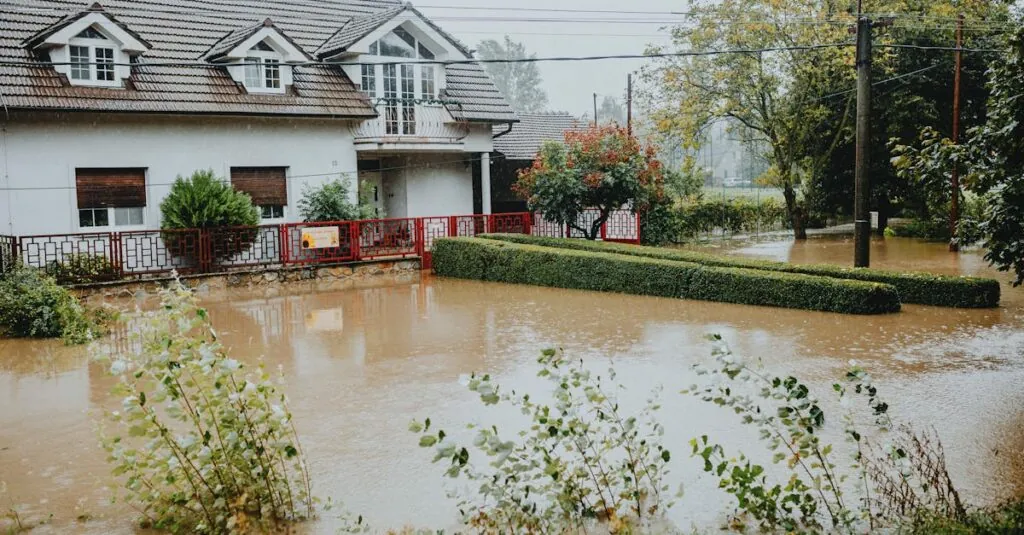Table of Contents
ToggleWhen storms roll in and unleash their fury, homeowners often find themselves in a whirlwind of worry. Will that rogue tree branch leave a dent in their roof? Will the basement turn into an indoor swimming pool? The big question looms: does home insurance cover storm damage? It’s a topic that can leave even the most seasoned homeowners scratching their heads.
Navigating the fine print of insurance policies can feel like deciphering ancient hieroglyphs, but understanding coverage is crucial. Home insurance can be a lifesaver—or a source of frustration—when storm clouds gather. With a little clarity, homeowners can confidently weather any storm, knowing their investment is protected. So grab your umbrella and let’s dive into the details of storm damage coverage.
Overview of Home Insurance
Home insurance provides financial protection against various risks. Coverage typically includes damage to the structure, personal belongings, and liability for injuries occurring on the property. Policies generally fall into different categories, such as dwelling, personal property, and additional living expenses.
Dwelling coverage protects the home’s structure from hazards like fire, theft, and vandalism. Personal property coverage replaces items like furniture and electronics if they’re stolen or damaged. Additional living expenses coverage pays for temporary housing if a home becomes uninhabitable due to covered events.
Homeowners should review policy details to understand exclusions, limits, and deductibles. Some standard policies might not cover specific categories of storm damage. Flood and earthquake damage often require separate endorsements or specialized policies, which homeowners must consider when securing comprehensive coverage.
Understanding specific risk factors is crucial. Homeowners in flood-prone areas may need to invest in flood insurance to ensure complete protection. Local weather patterns and historical storm data help assess potential vulnerabilities.
Insurance providers use various factors to determine premiums. These include home location, age, and condition. Generally, knowledge of these influencing elements aids homeowners in making informed decisions about coverage needs.
Regularly reviewing and updating policies ensures homeowners maintain adequate protection as circumstances change. Modifications in lifestyle or additions to a home could influence coverage requirements. Keeping insurance information current is essential in navigating the complexities of storm damage coverage effectively.
Common Types of Storm Damage
Understanding common types of storm damage helps homeowners recognize potential risks and insurance coverage.
Wind Damage
Wind damage can devastate properties during storms. Strong winds often uproot trees, leading to substantial structural damage and costly repairs. Broken windows or torn roofs frequently result from high-speed gusts. Many insurance policies cover wind damage, but homeowners should review their specific policy exclusions. Knowing the coverage details ensures they receive appropriate compensation after an incident.
Flood Damage
Flood damage presents significant risks, especially in areas prone to heavy rainfall or hurricanes. Water intrusion can cause extensive damage to flooring, walls, and personal belongings. Standard home insurance policies typically exclude flood coverage. Homeowners often need to purchase a separate flood insurance policy to protect against this type of damage. Understanding local flood zone designations and historical storm patterns aids in assessing vulnerabilities.
Hail Damage
Hail damage affects many homes during severe thunderstorms. Hailstones can break roofs, shatter siding, and damage windows, leading to costly expenses. Most homeowners’ insurance policies include hail damage coverage, but limits may apply. It remains essential to document any hail damage immediately after a storm. Taking photos and filing prompt claims helps ensure homeowners receive timely repairs and compensation.
Understanding Coverage
Home insurance policies vary in terms of coverage for storm damage. It’s crucial for homeowners to understand the specifics of their policies to ensure adequate protection.
Standard Home Insurance Policies
Most standard home insurance policies include coverage for wind and hail damage. Homeowners benefit from this coverage, as significant structural issues can arise from strong winds or hailstorms. However, reviewing policy documents for detailed exclusions is essential. Not every situation meets the criteria for coverage, and some policies limit payouts based on the damage’s extent. Water damage due to storm-related events can be tricky, as some policies exclude flooding. Homeowners should examine their documents closely to see what qualifies for protection.
Additional Coverage Options
Homeowners can explore additional coverage options to protect against specific storm-related risks. Separate flood insurance is often necessary, particularly in flood-prone areas where standard policies may fall short. Earthquake coverage is another option to consider for those in seismically active regions. Umbrella policies provide extra liability coverage, adding another layer of security. Speaking with an insurance agent helps clarify available endorsements and ultimately strengthens coverage against unpredictable weather events. Regular review of available options ensures homeowners remain informed about their protection needs.
Factors That Affect Coverage
Understanding the factors that affect coverage is essential for homeowners navigating storm damage claims. Various elements impact the extent of protection provided by home insurance policies.
Policy Limits and Deductibles
Policy limits define the maximum amount an insurer will pay for a covered loss. Homeowners face different limits depending on their specific policy terms. Deductibles represent the amount a homeowner must pay out of pocket before the insurance coverage kicks in. High deductibles might lower premiums but can lead to increased expenses during a claim. For instance, if a policy has a $1,000 deductible and a $10,000 wind damage claim, the homeowner pays the first $1,000 and the insurer covers the remaining $9,000. Homeowners should regularly review these figures to ensure they align with their financial comfort levels.
Exclusions to Watch For
Exclusions can significantly impact coverage for storm damage. Many standard policies don’t cover flood damage, which commonly occurs during storms. Homeowners in flood-prone regions face a higher risk of loss with these exclusions. Earthquake damage may also fall outside standard coverage, necessitating additional policies. For example, hail damage is typically covered, but limits often apply, leaving homeowners vulnerable if damage exceeds those limits. Policyholders must read their insurance documents carefully to identify any exclusions. It’s crucial to consult an insurance agent for insights on possible endorsements that add necessary protection.
Steps to Take After Storm Damage
Documenting damage immediately holds high importance. Capture photographs or videos of affected areas, including the exterior and interior of the home. This documentation serves as essential evidence for insurance claims.
Next, assess the extent of the damage. Inspect the roof for missing shingles or leaks. Check windows for cracks or breaks. Water entry points often lead to additional complications, so thorough checks prevent future issues.
Contact the insurance provider as soon as possible. Provide them with documented evidence and a detailed description of the damage. This communication initiates the claims process and keeps timelines clear.
Starting temporary repairs on critical areas may be necessary. Cover damaged windows with plywood or tarps to prevent further weather exposure. Ensuring safety with these temporary fixes helps minimize additional damage and demonstrates proactive steps to insurers.
Keep all receipts from repairs and materials. These expenses may contribute to the claim amount, supporting financial recovery after storm damage. An organized approach strengthens the claims process.
Filing a formal claim follows after gathering all necessary information. Fill out the claim form accurately and submit it along with supporting documentation. Doing so expedites the process, ensuring a prompt response from the insurance company.
Lastly, stay in touch with the insurance adjuster. Regularly communicate updates or additional findings from repairs. Keeping open lines of communication facilitates timely resolutions and helps manage expectations throughout the claims process.
Understanding home insurance coverage for storm damage is essential for every homeowner. By knowing the specifics of their policy and any exclusions that may apply, they can better prepare for unpredictable weather events. Regularly reviewing coverage limits and considering additional policies can provide peace of mind and financial security.
Taking proactive steps after a storm, such as documenting damage and communicating with insurance providers, ensures a smoother claims process. With the right knowledge and preparation, homeowners can protect their investments and navigate the complexities of storm damage coverage effectively.







